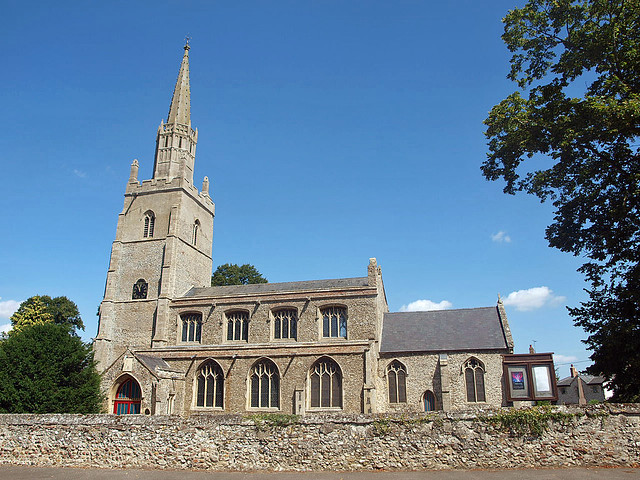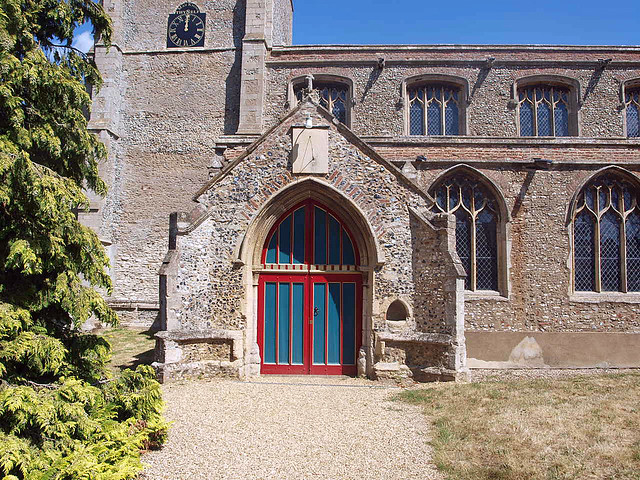ST GEORGE. Apart from the Dec E window with flowing tracery and the chancel arch, all is Perp here, and dominated by a steeple 120 ft high. Its distinguishing feature is the uncommonly slender panelled octagonal top stage. This rises behind the battlements and tall pinnacles of the square lower parts and ends in its own openwork parapet with pinnacles. The spire rises behind this and is crocketed. The tower has a W doorway with traceried spandrels and a hood-mould on lively busts, and a four-light window. The tower arch is tall and has demi-figures of angels instead of capitals. The same motif characterizes the capitals of the arcades, though some have impressive heads instead. The arcades have four bays, and the piers are given an odd section with slim polygonal projections to the arches and deep projections with two hollow chamfers to nave and aisles. The roof has alternating tie-beams and hammer-beams, the latter with carved angels. Perp windows all round, those of the clerestory segment-headed and oddly beetle-browed, those of the N aisle with transoms. Unusual sanctus bellcote on the SE corner of the nave. - COFFER. Iron-bound; C14. - BIER. Dated 1737, yet in its details still entirely pre-classical. - STAINED GLASS. In the chancel and the S aisle E window big figures of c.1850 in the style of the early C14. - In a N aisle window scenes by Henry Holiday, 1866, i.e. when he was young (made by Powell & Sons). The glass is very close to the Pre-Raphaelites in the figure style, but lacks Morris’s ornamental genius. Still - a remarkably good piece for its date. - MONUMENTS. Sir Adam de Clifton d. 1367. A splendid brass figure, 5 ft 9 in. tall. Under a canopy. - Henry Partridge d. 1793. Urn with profile head in black silhouette - a fashionable technique, here applied to memorial sculpture. - (Also Henry Partridge d. 1803 by Athow.)
METHWOLD. The medieval church of this quiet little town of 1200 folk stands finely through the frame of trees, rising high over the red roofed houses. Its tower is a striking landmark from the fenland, and is fine in itself with a beautiful lantern and a spire reaching 40 yards high.
Opposite the church, on the end of a row of timbered cottages, is an unusual and picturesque wall which is a fragment of a three-storeyed 16th or 17th-century house. A kind of projecting chimney climbing from the ground to the tip of the many-stepped gable is patterned with ornamental brickwork, and at each side of it are windows. The sides of the wall are stepped-out from the ground to meet the eaves of the adjoining cottage, and are then stepped-in to form the gable, so that the end looks much like a kite in shape.
The clock and the sundial greet us as we come to the clerestoried church, an attractive picture with its flint walls and parapets of brick and stone. Inside a soaring arch opens to the tower and a lower arch to the chancel, which is chiefly 14th century. Graceful arcades in the nave have mouldings continuous to the floor, but shafts inside the bays have capitals carved with modern angels and a doubled-up little man,
The finest thing in the church is the 15th-century oak roof looking down on the nave, its arched tie-beams alternating with hammerbeams, of which some have fine angels. There is a Jacobean table, and a little chest with iron bands and three locks is said to be at least 600 years old. Of our own century is the lovely oak screen with leaves and flowers in its tracery, and a roodloft reached by the old newel stairway, with its two original doorways. On an urn belonging to a marble memorial is a quaint silhouette of a man’s head with pursed lips and turned-up nose; he was Henry Parbridge, a Recorder of Lynn and a member of the Middle Temple in the 18th century.
A curious story belongs to the brass portrait of Sir Adam de Clifton, who died in 1367, for it only just escaped the melting pot. The brass was sold to a tinker in 1680, and when recovered was broken into 130 pieces. For many years these fragments lay in the old chest, till in 1888 they were built up like a jigsaw puzzle into the splendid figure of a lifesize knight in chequered armour, with a belt of flower medallions, pointed helmet, sword and dagger, and gauntlets on his praying hands. A lion sits at his feet, and over his head is the arch of a canopy. He is mounted on a wooden panel and the missing parts are painted in.
Opposite the church, on the end of a row of timbered cottages, is an unusual and picturesque wall which is a fragment of a three-storeyed 16th or 17th-century house. A kind of projecting chimney climbing from the ground to the tip of the many-stepped gable is patterned with ornamental brickwork, and at each side of it are windows. The sides of the wall are stepped-out from the ground to meet the eaves of the adjoining cottage, and are then stepped-in to form the gable, so that the end looks much like a kite in shape.
The clock and the sundial greet us as we come to the clerestoried church, an attractive picture with its flint walls and parapets of brick and stone. Inside a soaring arch opens to the tower and a lower arch to the chancel, which is chiefly 14th century. Graceful arcades in the nave have mouldings continuous to the floor, but shafts inside the bays have capitals carved with modern angels and a doubled-up little man,
The finest thing in the church is the 15th-century oak roof looking down on the nave, its arched tie-beams alternating with hammerbeams, of which some have fine angels. There is a Jacobean table, and a little chest with iron bands and three locks is said to be at least 600 years old. Of our own century is the lovely oak screen with leaves and flowers in its tracery, and a roodloft reached by the old newel stairway, with its two original doorways. On an urn belonging to a marble memorial is a quaint silhouette of a man’s head with pursed lips and turned-up nose; he was Henry Parbridge, a Recorder of Lynn and a member of the Middle Temple in the 18th century.
A curious story belongs to the brass portrait of Sir Adam de Clifton, who died in 1367, for it only just escaped the melting pot. The brass was sold to a tinker in 1680, and when recovered was broken into 130 pieces. For many years these fragments lay in the old chest, till in 1888 they were built up like a jigsaw puzzle into the splendid figure of a lifesize knight in chequered armour, with a belt of flower medallions, pointed helmet, sword and dagger, and gauntlets on his praying hands. A lion sits at his feet, and over his head is the arch of a canopy. He is mounted on a wooden panel and the missing parts are painted in.


No comments:
Post a Comment